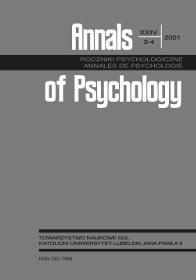Leftward Spatial Bias in Dialyzed Patients With End-Stage Renal Disease: A Sign of Right Hemispheric Attentional Activation or Impaired Left-Sided Disengagement?
Leftward Spatial Bias in Dialyzed Patients With End-Stage Renal Disease: A Sign of Right Hemispheric Attentional Activation or Impaired Left-Sided Disengagement?
Author(s): Natalia Mańkowska, Kenneth M. Heilman, John B. Williamson, Bogdan Biedunkiewicz, Alicja Dębska-Ślizień, Michał HarciarekSubject(s): Social Sciences, Psychology, Personality Psychology
Published by: Towarzystwo Naukowe KUL & Katolicki Uniwersytet Lubelski Jana Pawła II
Keywords: dialysis; line bisection; attentional bias; attentional disengagement; global attention; focal attention
Summary/Abstract: In the horizontal line bisection task, patients with end-stage renal disease (ESRD) treated with dialysis typically have an increase in the normal leftward attentional bias. It is not clear, however, whether this increased bias is related to an increase of attention toward left hemispace or impaired disengagement from left-sided stimuli. Non-demented patients with ESRD who were being treated with dialysis and demographically matched healthy controls attempted to bisect series of horizontal lines composed of two segments of unequal length and width, with the longer segment placed to the right or left. To test for the presence of a global spatial attentional bias, participants attempted to find the middle of the whole line. To test for focal attentional engagement and attentional disengagement, participants were asked to bisect only the longer segment of these compound lines. For the global condition, both patients and healthy controls were biased toward the longer segment and more so to the left. In the focal condition, when the longer segment was on the right side, both groups deviated their bisections toward the shorter segment. However, when in the focal condition the longer segment was on the left healthy controls deviated their bisection significantly more rightwards than did the patients, whereas with the longer segment on the right, the patients and healthy controls did not differ in their bias. These results suggest that the previously recognized dysfunction of the right fronto-subcortical attentional network in dialyzed patients might account for the results of the current study.
Journal: Roczniki Psychologiczne
- Issue Year: 24/2021
- Issue No: 3-4
- Page Range: 261-277
- Page Count: 17
- Language: English

